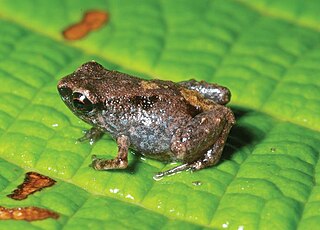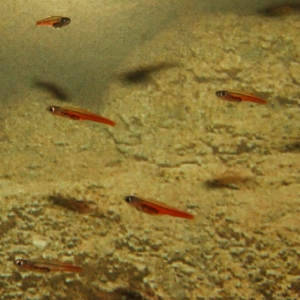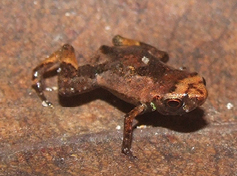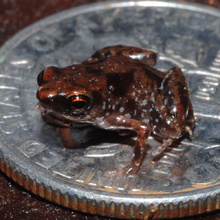Schindleria brevipinguis is a species of marine fish in family Gobiidae of Perciformes. Known as the stout infantfish, it is native to Australia's Great Barrier Reef and to Osprey Reef in the Coral Sea.

Schindleria is a genus of marine fish. It was the only genus of family Schindleriidae, among the Gobioidei of order Perciformes but is now classified under the Gobiidae in the Gobiiformes. The type species is S. praematura, Schindler's fish. The Schindleria species are known generically as Schindler's fishes after German zoologist Otto Schindler (1906–1959), or infantfishes. They are native to the southern Pacific Ocean, from the South China Sea to the Great Barrier Reef off eastern Australia, and Rapa Nui.
Trimmatom nanus, the midget dwarfgoby, is a species of marine goby native to the Indian Ocean and the western Pacific Ocean. It can mainly be found on oceanic drop-offs at depths of from 20 to 30 metres though it can occasionally be found in outer reef areas and lagoons at depths of from 5 to 35 metres. This species can reach a length of 1 centimetre (0.39 in) SL.

Asterophryinae is a subfamily of microhylid frogs distributed in an area from the Peninsular Malaysia through the Malay Archipelago to northern Australia.

Paedocypris is a genus of tiny cyprinid fish found in swamps and streams on the Southeast Asian islands of Borneo, Sumatra and Bintan.

Paedocypris progenetica is a species of tiny cyprinid fish endemic to the Indonesian islands of Sumatra and Bintan where it is found in peat swamps and blackwater streams. It was discovered by Singaporean ichthyologist Heok Hui Tan. He has written a description of the fish along with another species of the same genus called Paedocypris micromegethes.
The smallest organisms found on Earth can be determined according to various aspects of organism size, including volume, mass, height, length, or genome size.
Pristimantis cosnipatae, also known as Rio Cosnipata robber frog, is a species of frog in the family Strabomantidae. It is endemic to Cusco Department, Peru. It is believed to only occur in the Cosñipata Valley. The specific name cosnipatae refers to this valley. Last seen in 1999, this species is considered "critically endangered".
Choerophryne allisoni is a tiny species of frog in the family Microhylidae. It is endemic to Papua New Guinea and only known from its type locality, Mount Sisa in the Southern Highlands Province. The specific name allisoni honours Allen Allison, an American herpetologist. Common name Allison's mountain frog has been coined for this species.
Sphenophryne similis is a species of frog in the family Microhylidae. It is endemic to New Guinea and is only known from its type locality in the Owen Stanley Range, Northern Province, Papua New Guinea.
Microhyla borneensis, also known as the Matang narrow-mouthed frog, is a species of microhylid frog found in the Matang Range in Sarawak, Borneo. It was once the smallest known frog from the Old World. Adult males of this species generally have a snout–vent length (SVL) in the range of 10.6–12.8 mm (0.42–0.50 in), but may reach a maximum of 13 mm (0.51 in). Adult females have an SVL of 16–19 mm (0.63–0.75 in). The tadpoles measure just 3 mm.
Xenorhina subcrocea is a species of frog in the family Microhylidae. It is endemic to Papua New Guinea and is known from the New Guinean north coast, including coastal ranges between Vanimo and Lae. Common name Lae fanged frog has been coined for it.

The Brazilian gold frog, also known as Izecksohn's toad or flea-frog, is a very small species of frogs in the family Brachycephalidae. It is endemic to southeastern Brazil and is known from the central part of the state of Rio de Janeiro and from Serra das Torres in extreme southern Espírito Santo.

Paedophryne is a genus of microhylid frogs from Papua New Guinea, including D'Entrecasteaux Islands. All seven species known so far are amongst the smallest frog and vertebrate species.

Osprey Reef is a submerged atoll in the Coral Sea, northeast of Queensland, Australia. It is part of the Northwestern Group of the Coral Sea Islands. Osprey Reef is roughly oval in shape, measuring 25 by 12 kilometres, and covers around 195 square kilometres (75 sq mi). It has a perimeter of 69.5 kilometres (43.2 mi). The central lagoon is only 30 metres (98 ft) deep.

Paedophryne swiftorum is a species of frog from Papua New Guinea discovered in 2008 and formally described in January 2012. It lives among leaf litter on the tropical rainforest floor and was named after the Swift family who had provided funds for establishing the Kamiali Biological Station where the new species was found.
Eugênio Izecksohn was a Brazilian herpetologist. Izecksohn graduated from Universidade Federal Rural do Rio de Janeiro in 1953. Among others, he discovered and scientifically described the flea frog Brachycephalus didactylus, one of the smallest frogs in the world. Several taxa have been named in honour of him, mostly frogs like the tiny B. izecksohni, and the extremely rare—if not already extinct—Bokermannohyla izecksohni, but also a few from other groups like the fish Xenurolebias izecksohni and the bat Myotis izecksohni.

In biological taxonomy, a species nova is a new species. The phrase is Latin, and is used after a binomial name that is being published for the first time.

Brachycephalus pulex, also known as the Brazilian flea toad and the Serra Bonita flea toad, is a species of small frogs in the family Brachycephalidae. It is one of more than 35 named species within the genus Brachycephalus. It has been suggested to represent the smallest known vertebrate, with an average snout–vent length of 7.10 millimetres (0.280 in) in mature males.












